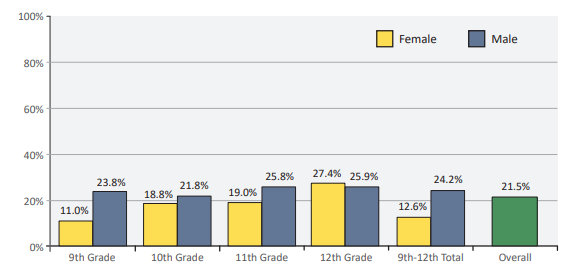Recently, the CDC released an update on the outbreak of EVALI (E-cigarette, or Vaping, Product Use-Associated Lung Injury). Discover how common vaping is in Idaho, and among Idaho youth. Then learn more about related health risks below.
Important Statistics:
- 82% of patients hospitalized with EVALI reported using tetrahydrocannabinol (THC) products. Vitamin E acetate, a common additive to THC vaping products, has also been linked to the EVALI outbreak.
Are things getting better?
- Incidence of reported EVALI cases dropped drastically since it last peaked in September 2019 with 215 per million weekly hospital admissions. The most recent rate is 35 per million for the week of January 5, 2020. The CDC suggests that the decrease in the reported cases of EVALI has been caused by increased awareness of the risk associated with vaping THC containing products, removal of Vitamin E acetate from products, and action from law enforcement agencies to reduce the supply of “informally sourced THC-containing products”.
How common is vaping in Idaho?
- It is becoming increasingly more common. From 2017 to 2018, vaping among high school students rose 78%. Middle school students saw a 48% increase in vaping. As seen in the figure below, a little over 1 in 5 students vape. Compared to the rate of traditional tobacco usage like smoking (5.3 % overall) or chewing tobacco/snuff/dip (4.7% overall), vaping is pervasive among students.
Percentage of Idaho students who use vaping products on one or more of the last 30 days:

(Credit: Idaho Department of Education, Idaho Youth Risk Behavior Survey )
What steps are being taken to reduce the prevalence of vaping among students?
- The Idaho Office of Drug Policy just launched a new vaping prevention program aimed at providing parents with information about vaping health risks, what vaping products look like, and prevention tips. Be the Parents.
We spoke with Nolan Bybee, a respiratory therapist at Madison Memorial Hospital about the vaping crisis.
What prevention tips do you have for those who want to quit vaping?
- Nolan: Compliance is hard. Some people find that nicotine gum works, some find success with patches. Some see vaping as a cigarette replacement, which is not accurate. Chemicals in e-cigarettes are not regulated as well as traditional cigarettes.
What are some of the risks associated with vaping?
- Nolan: Vaping is not nearly as regulated as cigarettes are, and that has led to various toxic substances being added to the liquid. There are known carcinogens in vaping liquid, for example formaldehyde, which is used as a preservative. This shows that nicotine is not the only problem. We are learning more and more as time goes on. Use coats the inside of your lungs with whatever substance is in the liquid. Some people add essential oils to their liquid, which leads to its own problems. On rare occasions, the battery inside the e-cigarette has exploded, or started fires inside glove boxes, for example. E-cigarettes have a larger opening compared to traditional cigarettes, so each hit provides more nicotine than traditional cigarettes. This leads to people being addicted to nicotine much faster than cigarettes. Many people do not know how much nicotine they are actually consuming
Why is vaping so hard to notice among teens and young adults?
- Nolan: Many devices look just like flash drives. Teachers may think a student just dropped a flash drive instead of a contraband smoking device in class. In class, it may look like a student is chewing on the drawstring of a hoodie, but there are some hoodies with a straw that comes down for concealed vaping. This may be one of the draws of vaping- the forbidden aspect.
How does vaping affect the lungs?
- Nolan: There are so many things that are not meant to go into your lungs. Anytime you start breathing in things, you introduce allergens, which can lead to an allergic reaction. Vaping causes the lungs to be less flexible. The air sacs in the lungs are blown up so much so they do not retain their original shape. The cilia, hairs which move mucus out of the lungs, also become paralyzed by the nicotine. This is what causes smoker’s cough. The cilia no longer are able to remove the mucus, and the lungs become a warm moist environment which can grow bacteria. This bacteria growth is what causes pneumonia.
